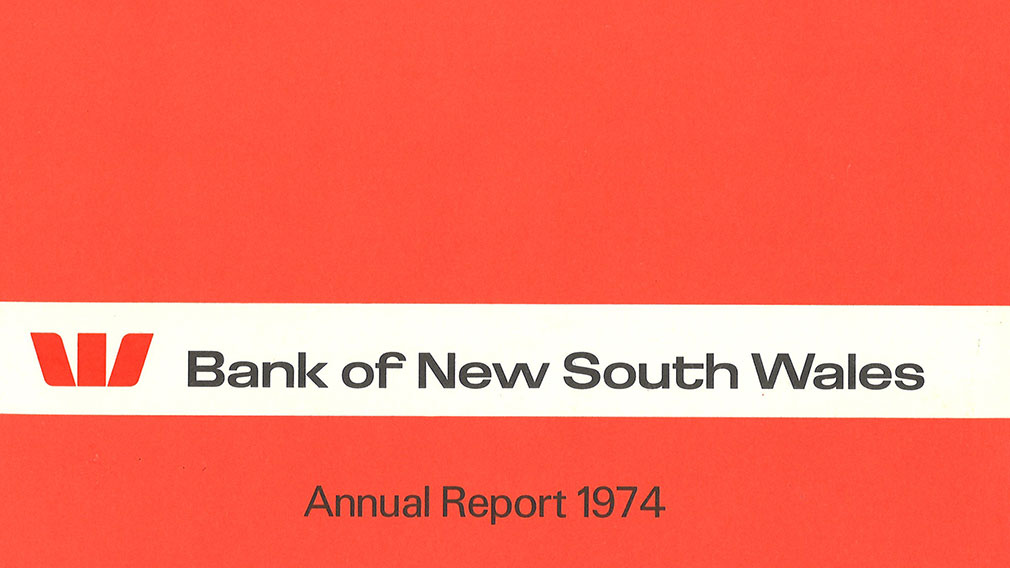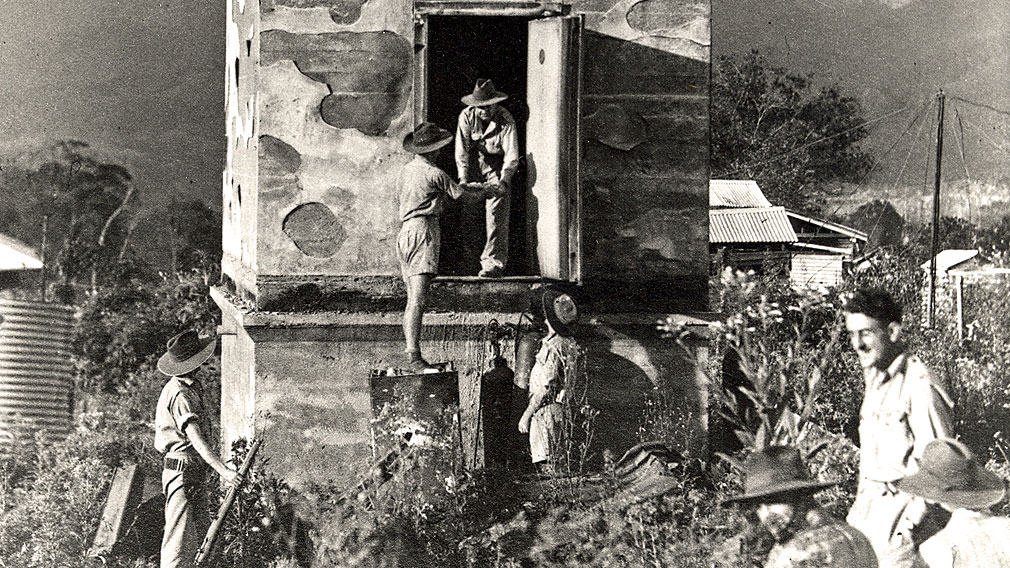The ‘bankies’ who survived the bombing of Darwin
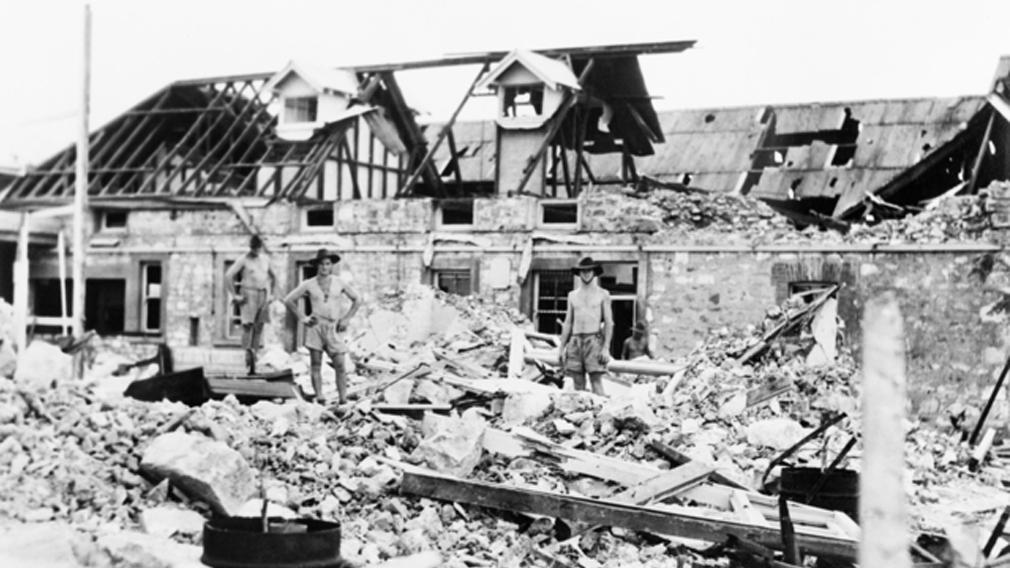
More than 230 people died and many buildings destroyed – including the post office (pictured) – during the WW2 bombing of Darwin on February 19, 1942. (Australian War Memorial)
“As we were about to open the doors, the air raid sirens began to wail, and the bombs began to drop simultaneously.”
So wrote John Coverdale, a young employee of the Darwin branch of the Bank of New South Wales (now Westpac), recalling the day the Northern Territory’s capital was blasted by the first of an astounding 64 air raids during World War Two.
I discovered Coverdale’s moving first-hand account among Westpac’s private archives, as we approach the 80-year anniversary since that dreadful day, February 19, 1942.
While not the only Australian town to have been hit by air and sea raids during the war, Darwin suffered by far the most, bearing 75 per cent of the 85 or so bombing raids on the country, the last of the bombs dropping in November 1943, almost two year later.
The aggressive bombing on Darwin by the Japanese Empire – the largest single attack ever mounted by a foreign power on Australia – reflected the town’s strategic location as a base from which military aircraft could be deployed to defend neighbouring countries to the north.
It was indeed this same aircraft infrastructure – which had grown since the capital had become an overnight stop for an increasing number of international civilian flights during the 1930s – that had seen the expansion of the bank’s operations in Darwin to support the town’s trade and commerce.
Coverdale was one of four bank personnel stationed at the time in Darwin – which had a pre-war population of 5,800 – based in the branch that was to take a direct hit from two anti-personnel incendiary bombs.
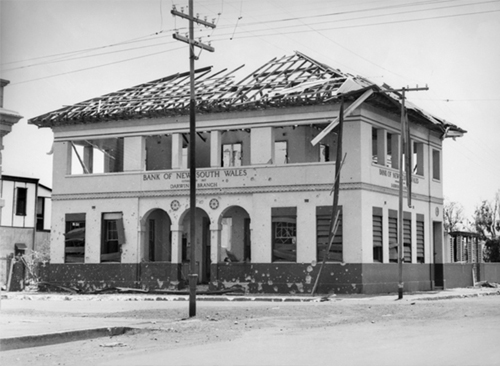
Damage to the Bank of NSW’s Darwin branch after it was bombed in August 1942. (Australian War Memorial)
In the lead up to the air raid, Darwin had been on alert, the atmosphere having been given “a severe jolt”, as described in Coverdale’s recollection recorded some 30 years later and stored in the bank’s historic collections. The trigger for the alarm, he said, was the historic moment a few months earlier on December 7, 1941, when the United States forces suffered the military strike at Pearl Harbour, marking the start of the Pacific War.
That event, he said, prompted the local administrators to advise all women to evacuate Darwin (including the bank manager’s wife). The bank staff who remained, moved into the residence above the bank.
“We spent spare time when available digging a series of zig-zag air raid slit trenches in the backyard of the bank,” Coverdale recalled.
“It was quite a grand structure in the end, covered with galvanised iron to keep out the tropical rains, and opening up into a dugout with shelves where we stashed some rations and a few bottles of beer.”
It was this shelter to which the personnel fled as the sirens wailed on that fateful morning of February 19, after hastily grabbing the cash and books they’d earlier laid out, as usual, ready to commence business.
“The raid lasted about 45 minutes and was a savage blitz,” Coverdale recalled.
“In that short time the damage inflicted made it a major disaster for Darwin. The Post Office received a direct hit and 10 of the staff were killed. Many homes and buildings were destroyed. The greatest damage occurred to shipping and to wharves.
“About an hour after the first raid, the enemy bombers returned to concentrate on the RAAF drome, plastering the runways, hangars and buildings, involving large scale destruction.
"Official records put the number of civilians killed or missing as 250-300.”
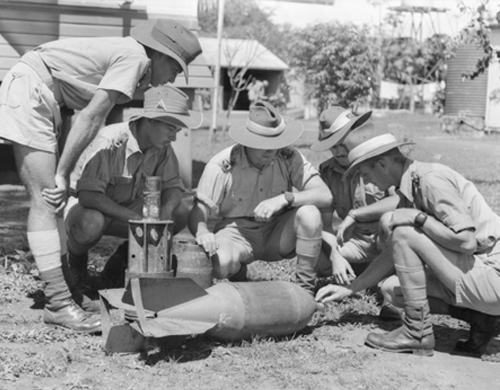
Officers with unexploded incendiary bomb in November 1942. (Australian War Memorial)
Coverdale notes that following the raid, there was confusion and uncertainty as to the future, as word came that all business in Darwin were to close as it transformed into a military town. It would remain that way until after the war ended in August 1945.
The managers of the town’s various banks, including the Bank of New South Wales, swiftly commandeered a truck and began the 3000-kilometre drive south to transport the bulk of cash and essential records to the banks’ Adelaide branches.
“After some quick preparations, our manager left, leaving the remaining staff in the town, at which point we all reported to Army headquarters Larrakeyah to enlist,” he wrote.
Although the Bank of NSW branch was surprisingly unscathed in the first raid, as the tempo of raids increased through the year, it eventually took a direct hit in August 1942. The damage was extensive, the resulting fire destroying all furniture and fittings and badly buckling the combination dials and handles on the strongroom door.
The outer walls were also damaged by another bomb exploding directly in front of the building. One of the two brass names plates attached to the building that suffered shrapnel damage remains in the branch to this day, while the other forms part of the national war memorial collection in Canberra.
The branch remained closed until in March 1946, re-opening in temporary premises on a vacant block alongside the damaged building while repairs were undertaken. The building was restored – the bank’s Supervisor of Works reporting that “the concrete walls of the old building had stood up very well to the bombing and strafing” – and its doors re-opened in 1955.
As for Coverdale?
He and his Darwin branch colleagues were among 4445 bank staff – and almost a million other Australians – to enlist.
They served in both Darwin and New Guinea with the Australian Imperial Forces.
Fortunately, they were all among the 38 per cent of the bank’s enlisted staff to survive.
Lest we forget.


